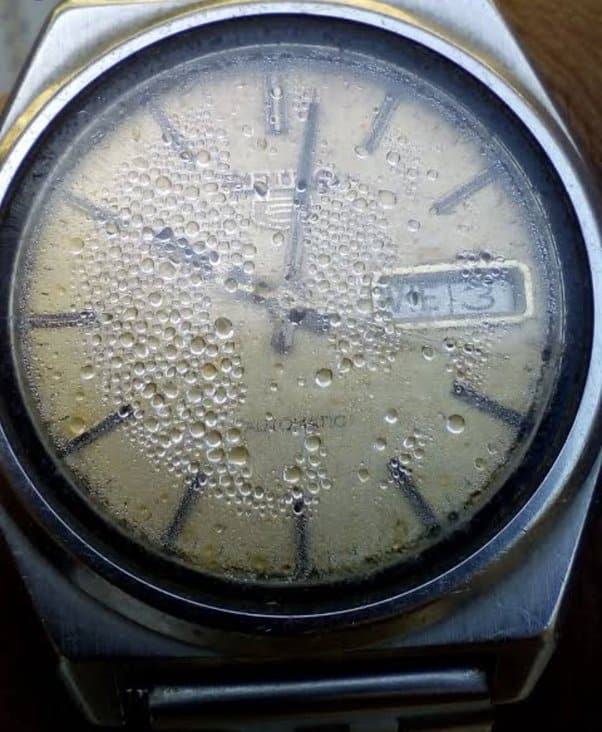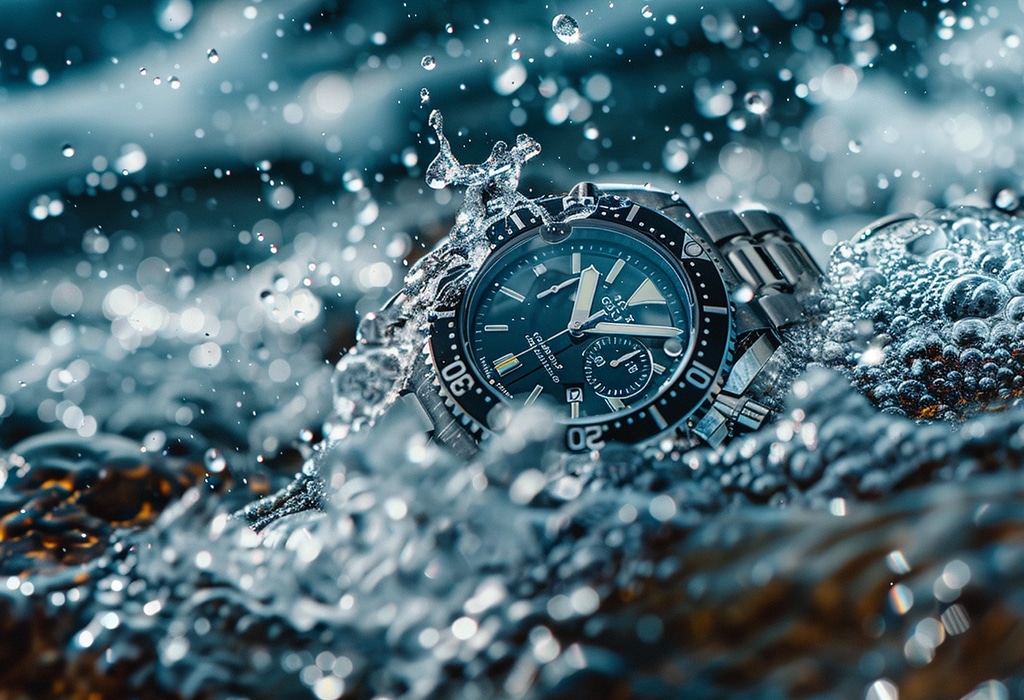Blog about Watches, Jewelry & Bags, Watch Blog
How to Handle Water and Moisture in Watches Easily at Home
Encountering water damage in your watch is a common issue that can significantly affect its accuracy and longevity. This comprehensive guide from Py-Luxury will walk you through understanding water resistance ratings and provide detailed steps on how to deal with water and moisture in your watch at home effectively.
1. Understanding the Water Resistance Rating of Your Watch
The water resistance rating (WR – Water Resistance) indicates how well a watch can withstand exposure to water. This rating is determined through various tests conducted under specific water pressure and depth conditions in a laboratory setting.
Common Water Resistance Indicators on Watches:
- WR (Water Resistance): This is often used to measure water resistance in meters. For example, WR 30 indicates that the watch can withstand water pressure at a depth of 30 meters. However, it does not mean you can dive 30 meters underwater with the watch; it only suggests it can resist equivalent pressure.
- BAR: This unit measures water pressure and is commonly used in Europe. 1 BAR is equivalent to the pressure at a depth of 10 meters. Therefore, a watch rated at 5 BAR can withstand water pressure at a depth of 50 meters.
- ATM (Atmospheres): This unit is widely used globally. For instance, 1 ATM is approximately equal to 1 BAR, meaning the watch can withstand water pressure at a depth of 10 meters. A watch rated at 10 ATM can handle water pressure at a depth of 100 meters.
2. Signs Your Watch Has Water Damage
You can identify water damage in your watch through the following signs:
- Condensation on the watch face: Small droplets of water appear inside the watch face.
- Water sounds inside the watch: You can hear water sloshing inside the watch when you shake it.
- Water leaking from the watch: Water leaks out when you shake the watch, even though it appears dry externally.
- Slowing or stopping watch: The watch begins to run slow or stops working altogether.
- Rust or metal discoloration: Signs of rust or discoloration on the metal parts of the watch.

3. Causes of Water and Moisture in Watches
Failing to properly secure adjustment crowns:
- The most common cause is not securely fastening the adjustment crowns. When the crowns are not tightly closed, water can easily seep through the gaps, leading to water damage despite the watch’s water-resistant features.
Exceeding the watch’s water resistance capacity:
- Each watch model has a specific water resistance level, typically indicated on the watch face or back. For example, a watch with a water resistance rating of 30 meters (3 BAR/3 ATM) is suitable for light water exposure, such as rain or handwashing. Exceeding this limit, such as swimming or diving, can cause water to infiltrate the watch.
Sudden exposure to extreme temperatures:
- Sudden temperature changes can cause condensation to form inside the watch. Prolonged exposure to high temperatures can also damage internal components, reducing the watch’s water resistance.
Exposure to chemicals or high salt content:
- Contact with chemicals or saltwater (like seawater) can corrode and damage the watch. Even sweat can cause moisture to seep in if not cleaned properly.
Strong impacts causing cracks:
- Hard impacts can create small cracks in the watch case or glass, allowing water to penetrate and cause condensation inside the watch.
4. Methods to Handle Water and Moisture in Watches
Placing the watch in rice or silica gel packs:
- Rice has excellent moisture-absorbing properties. Place the watch in a bowl of rice to draw out the moisture. Before placing it, pull out the adjustment crowns to create openings. To prevent dust and insects from entering, wrap the watch in tissue paper before placing it in the rice.
- Silica gel packs are also effective. Place the watch in a box with silica gel packs around it. This method may take longer, but it helps absorb moisture from the watch.
Using a dry cloth or soft fabric:
- Wrap a dry, absorbent tissue around the watch and place it face down to allow the tissue to draw out the moisture. Alternatively, use a soft cloth to wipe the watch. However, this method is not effective if the watch has significant water damage.
Wearing the watch in reverse:
- Some people believe wearing the watch upside down can help. The body heat can cause the moisture to evaporate and accumulate elsewhere inside the watch. However, this method is only suitable for minor moisture issues and not for severe water damage.
Using a hairdryer:
- Use a hairdryer to blow warm air on the watch to evaporate the moisture. Keep a safe distance to avoid overheating and damaging the internal components of the watch.
Placing the watch under a lamp:
- Place the watch under a desk lamp. The heat from the lamp can help evaporate the moisture. Ensure the lamp is close enough to provide adequate heat but not so close as to overheat and damage the watch components.
Taking the watch to a professional service center:
- For severe water damage, it is best to take the watch to a professional service center. They have the tools and expertise to repair and restore the watch to its original condition. Home remedies are only temporary solutions and might not fully resolve the issue if the water damage is extensive.
5. Preventing Water Damage in Watches
- Follow the water resistance rating: Use the watch according to its water resistance rating. Choose watches with a rating of 5 ATM or higher for activities involving water exposure, such as swimming or showering.
- Avoid adjusting the watch in extreme temperatures or underwater: Ensure the adjustment crowns and back case are securely closed before exposing the watch to water.
- Regularly check the water resistance and moisture levels: Periodically check and maintain the watch to ensure it remains water-resistant.
- Handle the watch with care: Avoid improper handling of the adjustment crowns, which can cause damage. If the watch suffers a hard impact, have it inspected and repaired promptly to avoid cracks that can lead to water damage.
By following these guidelines, you can effectively handle and prevent water and moisture damage in your watch, ensuring its longevity and accurate performance.
6. Detailed Steps to Handle Water and Moisture in Watches at Home
Step 1: Immediate Actions
When you first notice water or moisture in your watch, take immediate action to minimize damage.
- Remove the watch: Take off the watch immediately to prevent further water ingress.
- Dry the exterior: Use a soft cloth to dry the exterior of the watch as much as possible.
- Open the crowns and case back: If possible, open the adjustment crowns and case back to allow air to circulate and aid in drying out the internal components. Be cautious not to damage the seals.
Step 2: Using Desiccants
Desiccants are materials that absorb moisture. Rice and silica gel packs are common household desiccants.
Using Rice:
- Prepare a bowl of uncooked rice: Fill a bowl with uncooked rice.
- Wrap the watch: Wrap the watch in tissue paper to protect it from dust and insects.
- Submerge the watch: Place the wrapped watch in the rice, ensuring it is fully covered.
- Leave it for 24-48 hours: Let the watch sit in the rice for at least 24-48 hours to allow the rice to absorb the moisture.
Using Silica Gel Packs:
- Prepare a container: Get an airtight container.
- Place silica gel packs: Put several silica gel packs at the bottom of the container.
- Place the watch: Place the watch in the container and surround it with more silica gel packs.
- Seal the container: Close the container and leave it for 24-48 hours to let the silica gel absorb the moisture.
Step 3: Using Heat Sources
Heat can help evaporate moisture inside the watch. However, be cautious with the amount of heat applied.
Using a Hairdryer:
- Set to a low heat setting: Use a hairdryer on a low heat setting.
- Maintain a safe distance: Keep the hairdryer at a safe distance to avoid overheating.
- Blow warm air: Blow warm air on the watch for 15-20 minutes, focusing on the areas with visible moisture.
Using a Desk Lamp:
- Place the watch under a desk lamp: Position the watch under a desk lamp.
- Maintain a close but safe distance: Ensure the lamp is close enough to provide heat but not too close to overheat the watch.
- Leave it for several hours: Allow the watch to sit under the lamp for several hours to let the heat evaporate the moisture.
Step 4: Using Absorbent Materials
Absorbent materials like tissues and soft cloths can help draw out moisture.
- Wrap the watch in absorbent tissue: Wrap the watch in dry, absorbent tissue.
- Place the watch face down: Place the wrapped watch face down on a flat surface.
- Leave it for several hours: Allow the tissue to absorb the moisture over several hours.
7. Professional Repair Services
While home remedies can be effective for minor moisture issues, severe water damage requires professional repair services. Professional watchmakers have the tools and expertise to disassemble, clean, and repair the watch components properly.
- Find a reputable service center: Look for an authorized service center for your watch brand.
- Describe the issue: Provide a detailed description of the water damage.
- Request an estimate: Ask for an estimate of the repair costs and timeframe.
- Authorize the repair: If the estimate is acceptable, authorize the repair work.
8. Maintenance Tips to Prevent Water Damage
- Regularly check seals and gaskets: Ensure the seals and gaskets are intact and not worn out.
- Avoid extreme temperature changes: Gradual temperature changes are less likely to cause condensation.
- Clean the watch regularly: Remove dirt and sweat from the watch to prevent corrosion.
- Store the watch properly: When not in use, store the watch in a dry place away from direct sunlight and moisture.
Conclusion
Handling water and moisture in watches requires timely and appropriate action. By understanding the water resistance ratings, recognizing the signs of water damage, and using effective home remedies, you can protect your watch from significant damage. However, for severe issues, it is crucial to seek professional repair services to ensure the watch is restored to its optimal condition. Regular maintenance and careful handling can prevent future water damage, ensuring your watch remains a reliable and cherished accessory for years to come.
Read more: Watch Blog at Py-Luxury

